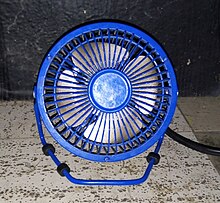
Back مروحة (آلة) Arabic Ventilador AST Bentilador BCL Вентылятар Byelorussian Вентилатор Bulgarian Ventilador Catalan Hŭng-siéng CDO Dagitungin CEB Ventilátor Czech Gwyntyll (peiriant) Welsh



A fan is a powered machine used to create a flow of air. A fan consists of a rotating arrangement of vanes or blades, generally made of wood, plastic, or metal, which act on the air. The rotating assembly of blades and hub is known as an impeller, rotor, or runner. Usually, it is contained within some form of housing, or case.[1] This may direct the airflow, or increase safety by preventing objects from contacting the fan blades. Most fans are powered by electric motors, but other sources of power may be used, including hydraulic motors, handcranks, and internal combustion engines.
Mechanically, a fan can be any revolving vane, or vanes used for producing currents of air. Fans produce air flows with high volume and low pressure (although higher than ambient pressure), as opposed to compressors which produce high pressures at a comparatively low volume. A fan blade will often rotate when exposed to an air-fluid stream, and devices that take advantage of this, such as anemometers and wind turbines, often have designs similar to that of a fan.
Typical applications include climate control and personal thermal comfort (e.g., an electric table or floor fan), vehicle engine cooling systems (e.g., in front of a radiator), machinery cooling systems (e.g., inside computers and audio power amplifiers), ventilation, fume extraction, winnowing (e.g., separating chaff from cereal grains), removing dust (e.g. sucking as in a vacuum cleaner), drying (usually in combination with a heat source) and providing draft for a fire. Some fans may be indirectly used for cooling in the case of industrial heat exchangers.
While fans are effective at cooling people, they do not cool air, but rather work by evaporative cooling of sweat and increased heat convection into the surrounding air, due to the airflow from the fans. Thus, fans may become less effective at cooling the body if the surrounding air is near body temperature and contains high humidity.
© MMXXIII Rich X Search. We shall prevail. All rights reserved. Rich X Search